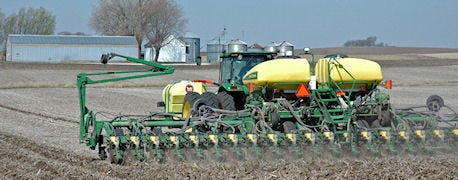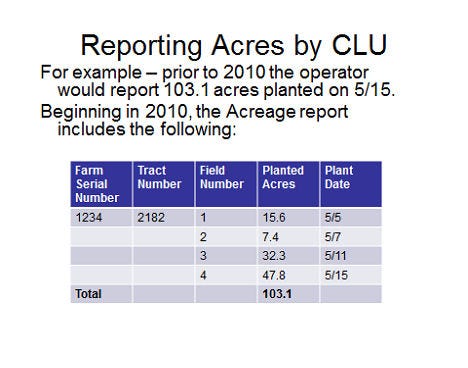May 8, 2012

Everyone who plants an insured crop should be keeping track of the date they planted each field and how many acres were planted to that crop. That information has to be reported to your local Farm Service Agency (FSA) office on FSA form 578—the acreage report. Keep in mind you will likely be asked to document that information by FSA farm and tract number.
For 2012, this information must be filed by July 15 to your local FSA office. A copy of the completed FSA form should be provided to your crop insurance agent. Note that this date is slightly later than the typical June 30 deadline Iowa has had in the past.

Planting Records To Keep For FSA
Steve Johnson, an Iowa State University Extension farm management specialist in central Iowa provides the following update and related information regarding acreage reporting requirements and crop insurance changes for 2012.
Acreage reporting and crop insurance changes to keep in mind
* Deadline is July 15 for spring planted crops—two weeks earlier than normal in Iowa.
* Crop insurance billing date is August 15 and a penalty will be attached for late payment of premiums. The premium has to be received by October 1 to avoid the penalty. This is a month earlier than in the past.
* Farm operator needs to report crops planted, practice (irrigated vs. non-irrigated), number of acres and planting date.
* FSA Form 578 needs to include farm serial number, tract number and field number.
* FSA assigns each farm, tract and field a unique identifier called a Common Land Unit (CLU).
USDA is moving farmers to a map-based acreage report system

USDA is moving farmers to a map-based acreage report system
In an effort to have consistent data between the USDA Farm Service Agency and the USDA Risk Management Agency, a CLU reporting system has been developed by USDA. At acreage reporting time, the producer will need to report by field the crop and when it was planted. A CLU Identification (ID) will be generated for each field. Underlying this CLU ID will be the farm legal description, farm serial number, tract number and filed identification.
Many crop insurance agents are already using CLU information to create map-based reports. Some of the advantages being reported by farmers include:
* Easier to report acres, dates the crop was planted and easier to track data using maps.
* Fewer reporting errors as field boundaries are easier to identify.
* Map-based reports can be compiled immediately after planting and provided to the FSA office to speed up certification on FSA Form 578.
Maps are easier for crop insurance adjusters to verify policy information, adjust claims and provide faster turnaround time for indemnity payments. Map-based reports make the integration of precision technology much easier.
CLU Acreage Reporting Plan:
* The new CLU identification system is a globally unique identifier associated with each field.
* Acreage reporting at the CLU level is targeted at 50% of all crop acreage in the U.S. by 2012 and 100% by 2016.
* CLUs, each with unique field boundaries will become the new format for electronic data management.
Provide your acreage report to FSA well in advance of July 15
Since the crop insurance billing date has been moved up to August 15, you should work with your crop insurance agent now to create a map-based report to assist in the completion of the FSA Form 578. If you choose to complete this FSA Form 578 first, provide a copy of that acreage report to your insurance agent well in advance of the July 15 deadline to assure more timely crop insurance data entry and receipt of your premium notice.
"Remember, the 2012 crop insurance premium is due in September. To avoid a penalty, payment must be received by October 1, which is one month earlier than in the past," notes Johnson. "Always contact your crop insurance agent if you have particular questions or concerns regarding your policy or coverage."
For farm management information and analysis, go to ISU's Ag Decision Maker site www.extension.iastate.edu/agdm and ISU Extension farm management specialist Steve Johnson's site www.extension.iastate.edu/polk/farmmanagement.htm.
You May Also Like




